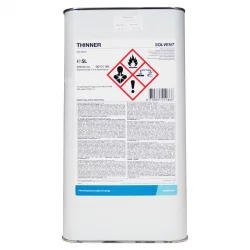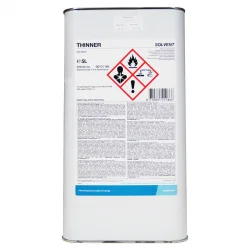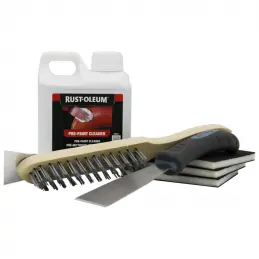- There are no more items in your cart
- Shipping Calculated at checkout
- Sub-Total (inc. VAT) £0.00
SigmaShield 400, formerley known as Amerlock 400 GF, is a two-component, high solids polyamine adduct cured epoxy coating, designed to prevent corrosion under insulation (CUI) of carbon steel and stainless steel. Glass flake reinforced for improved impact and abrasion resistance.
- Pass cryogenic cyclic test from -196°C (-321°F) to 200°C (392°F)
- Excellent resistance to corrosion, for long-term protection at areas subject to heavy wear and tear
- Very low water permeability, due to glass flake barrier; suitable for immersion service
- Compatible with cathodic protection systems
- Up to 750 µm (30.0 mils) DFT in a single coat
- Withstands continuous heat up to 218°C (420°F)
- Touch dry in 6 hours - refer below for more details on spreading rate and film thickness, overcoating intervals and curing times
SigmaShield 400, formerley known as Amerlock 400 GF, a two-component, high solids glass flake reinforced polyamine adduct cured epoxy coating designed to prevent corrosion under insulation (CUI) of carbon steel and stainless steel, for long-term protection at areas subject to heavy wear and tear.
The coating has very low water permeability (due to glass flake barrier), making it suitable for immersion service, and is compatible with cathodic protection systems. It has passed cryogenic cyclic test from -196°C (-321°F) to 200°C (392°F)
Features & Benefits
- Formerley known as Amerlock 400 GF
- Two-component
- High solids
- Reinforced high solids polyamine adduct cured epoxy
- Designed to prevent corrosion under insulation (CUI) of carbon steel and stainless steel
- Pass cryogenic cyclic test from -196°C (-321°F) to 200°C (392°F)
- Glass-flake reinforced for improved impact and abrasion resistance
- Excellent resistance to corrosion
- Long-term protection at areas subject to heavy wear and tear
- Very low water permeability, due to glass flake barrier
- Suitable for immersion service
- Compatible with cathodic protection systems
- Up to 750 µm (30.0 mils) DFT in a single coat
- Withstands continuous heat up to 218°C (420°F)
- Touch dry in 6 hours
- Refer below for more details on spreading rate and film thickness, overcoating intervals and curing times
- Used by Utgrunden Offshore Wind Farm, Baltic Sea, protecting against seawater immersion, strong winds, breaking waves, ice formation
Product Data
Two-component, reinforced high solids polyamine adduct cured epoxy coating.
Epoxy coatings will chalk and fade with exposure to sunlight. Light colours are prone to ambering to some extent. Note that product tinted to custom colours are not recommended for immersion service. Only use factory grind batches for immersion
| Data for mixed product | |
|---|---|
| Number of components | Two |
| Mass density | 1.5 kg/l (12.5 lb/US gal) |
| Volume solids | 87 ± 3% |
| VOC (Supplied) | max. 172.0 g/l (approx. 1.4 lb/US gal) |
| Temperature resistance (Continuous) | To 218°C (420°F) |
| Temperature resistance (Intermittent) | To 232°C (450°F) |
| Recommended dry film thickness | 200 - 750 µm (8.0 - 30.0 mils) depending on system |
| Theoretical spreading rate | 4.4 m²/l for 200 µm (174 ft²/US gal for 8.0 mils) |
| Dry to touch | 6 hours |
| Overcoating Interval | Minimum: 24 hours |
| Maximum: 3 months | |
| Full cure after | 8 days |
| Shelf life | Base: at least 24 months when stored cool and dry |
| Hardener: at least 36 months when stored cool and dry | |
Notes:
- Refer below for more details on spreading rate and film thickness, overcoating intervals and curing times
- Intermittent temperature resistance should be less than 5% of the time, and maximum 24 hours
- Maximum temperature in table is for dry condition refer further below for "System Specification" for corrosion under insulation (CUI) conditions
Surface Preparation
Recommended Substrate Conditions and Temperatures
Substrate conditions
- Previous coat must be dry and free from any contamination
Substrate temperature and application conditions
- Coating performance is proportional to the degree of surface preparation. Remove all loose paint, mill scale, and rust
- The surface to be coated must be dimensionally stable, dry, clean and free of grease, oil, and other foreign materials
- When proper abrasive blast surface preparation is not practical, surfaces should be chipped clean and wire brushed to bare, clean material
Carbon Steel
- For immersion service: steel; blast cleaned to ISO-Sa2½ (SSPC SP-10)
- For atmospheric service, abrasive blast to ISO-Sa2½ or minimum SSPC SP-6, power tool cleaned to ISO-St3 (SSPC SP-3) or hand tool cleaned to ISO-St2 (SSPC SP-2) or ultra high pressure water jet to SSPC SP WJ-2(L) / NACE WJ-2(L)
Concrete / Masonry
- Remove grease, oil and other penetrating contaminants according to ASTM D4258
- Abrade the surface per ASTM D4259 to remove all chalk and surface glaze or laitance. Achieve surface profile - ICRI CSP 3 to 5
- AMERCOAT 114 A may be used as a pit filler. Check with our Technical Team for an alternative
- Maximum recommended moisture transmission rate is 3 lbs / 1,000 ft2 / 24 hours by moisture transmission test (ASTM F1869, calcium chloride test or by ASTM D4263, plastic sheet test)
- Alternatively, ASTM D4944 (Calcium Carbide Gas method) can be used, moisture content should not exceed 4%
Galvanized steel
- Remove oil or soap film with detergent or emulsion cleaner
- Lightly abrasive blast with a fine abrasive in accordance with SSPC SP-16 guidelines to achieve a profile of 1.5 – 3.0 mils (38 – 75 µm). When light abrasive blasting is not possible, galvanizing can be treated with a suitable zinc phosphate conversion coating.
- Galvanizing that has had at least 24 months of exterior weathering may be coated after power washing to remove all contaminants and white rust
Non-Ferrous Metals and Stainless Steel
- Remove all rust, dirt, moisture, grease or other contaminants from the surface
- Lightly abrasive blast with a fine abrasive in accordance with SSPC SP-16 guidelines to achieve a profile of 40 - 100 µm (1.5 - 4.0 mils)
Substrate Temperature
- Substrate temperature during application and curing should be above 10°C (50°F)
- Substrate temperature during application and curing should be at least 3°C (5°F) above dew point
System Specification
Insulated and non-insulated service:
Applied direct to carbon steel or stainless steel up to 204°C (400°F)
- Amerlock 400 GF / SigmaShield 400 : 250 µm (10.0 mils) DFT one coat system
Notes:
- Do not exceed 400 μm (16.0 mils) total DFT
- Top coat needed for exposure in direct sunlight conditions. Please contact our technical team for suitable top coats
- For carbon steel surface treatment, ISO-Sa2½ or min. SSPC SP-6 is recommended. But SSPC SP-15 is allowed for repair
- For hot application from 66°C (150°F) to 150°C (300°F), please refer to "HOT APPLY EPOXIES" information sheet
Application
Instructions for Use
Mixing ratio by volume: base to hardener 50:50 (1:1)
- The temperature of the mixed base and hardener should preferably be above 15°C (59°F), otherwise extra thinner may be required to obtain application viscosity
- Adding too much thinner results in reduced sag resistance and slower cure
- Very good mechanical mixing of base and hardener is essential
- Thinner should be added after mixing the components
- Filters should be removed from spray equipment
Air Spray
Recommended thinner
Volume of thinner
- 6 - 10%, depending on required thickness and application conditions
Nozzle orifice
- 1.5 – 2.0 mm (approx. 0.060 – 0.079 in)
Nozzle pressure
- 0.3 - 0.4 MPa (approx. 3 - 4 bar; 44 - 58 p.s.i.)
Airless Spray
Recommended thinner
Volume of thinner
- 0 - 5%
Nozzle orifice
- Approx. 0.53 – 0.79 mm (0.021 – 0.031 in)
Nozzle pressure
- 19.0 - 22.5 MPa (approx. 190 - 225 bar; 2756 - 3264 p.s.i.)
Brush/roller
- Only for touch-up and spot repair
- Due to thixotropy, it is difficult to obtain a smooth film by brush, although this does not affect performance
Cleaning solvent
Spreading Rate and Film Thickness
Theoretical spreading rate
| DFT | Theoretical Spreading Rate |
|---|---|
| 200 µm (8.0 mils) | 4.4 m²/l (174 ft²/US gal) |
| 750 µm (30.0 mils) | 1.2 m²/l (47 ft²/US gal) |
Overcoating Interval for DFT up to 300 µm (12.0 mils)
| Overcoating with... | Interval | 10°C (50°F) | 20°C (68°F) | 30°C (86°F) | 40°C (104°F) |
|---|---|---|---|---|---|
| Various two-component epoxy coatings | Minimum | 36 hours | 16 hours | 10 hours | 8 hours |
| Maximum | 3 months | 3 months | 3 months | 1 months | |
| Polyurethanes | Minimum | 36 hours | 16 hours | 10 hours | 8 hours |
| Maximum | 1 month | 1 month | 14 days | 7 days |
Note:
- Surface should be dry and free from any contamination
- Adequate ventilation must be maintained during application and curing (please refer to information sheets 1433 and 1434)
Curing time for DFT up to 300 µm (12.0 mils)
| Substrate temperature | Dry to Touch | Dry to Handle | Full Cure |
|---|---|---|---|
| 10°C (50°F) | 24 hours | 48 hours | 21 days |
| 20°C (68°F) | 6 hours | 20 hours | 8 days |
| 30°C (86°F) | 4 hours | 12 hours | 4 days |
Notes:
- Adequate ventilation must be maintained during application and curing
Pot Life (at application viscosity)
| Mixed product temperature | Pot life |
|---|---|
| 10°C (50°F) | 3 hours |
| 20°C (68°F) | 2 hours |
| 30°C (86°F) | 1 hour |
Safety Precautions
- For paint and recommended thinners, see the relevant Material Safety Data Sheets in the attachments section above
- This is a solvent-borne paint and care should be taken to avoid inhalation of spray mist or vapor, as well as contact between the wet paint and exposed skin or eyes
References
- Conversion Tables (information sheet 1410)
- Explanation to product data sheets (information sheet 1411)
- Safety Indicators (information sheet 1430)
- Safety in Confined Space and Health Safety, Explosion Hazard - Toxic Hazard (information sheet 1431)
- Safe Working in Confined Spaces (information sheet 1433)
- Directives for Ventilation Practice (information sheet 1434)
- Cleaning of Steel and Removal of Rust (information sheet 1490)
- Specification for Mineral Abrasives (information sheet 1491)
- Relative humidity - Substrate Temperature - Air Temperature (information sheet 1650)
Data sheet
- Manufacturer
- PPG
- For Use On
- Galvanized Steel, Concrete, Masonry
- Application Method
- Brush, Roller, Spray
- Sheen
- Eggshell
- Colour
- Standard / Ready Mixed
- Single, Two or Three Pack
- Two-Pack
- Pack Size
- 20L
- Parts
- Two
- Base Type
- Glass flake reinforced polyamine cured
- Solvent
- Solvent-borne
- Mixing Ratio
- 1:1
- Suitable Substrates
- Carbon Steel, Stainless Steel, Concrete
- Key Features
- Designed to prevent corrosion under insulation (CUI) of carbon steel and stainless steel, excellent resistance to corrosion
- Application
- Brush, Roller, Spray
- Touch Dry (at 20°C)
- 6 hours
- Dry to Handle (at 20°C)
- 20 hours
- Dry to Recoat (at 20°C)
- Minimum: 24 hours. Maximum: 3 months
- Fully Cured (at 20°C)
- After 8 days
- Pot Life (at 20°C)
- 2 hours
- Coverage
- 4.4 m2/I for 200 µm (174 ft2/US gal for 8.0 mils)
- Recommended Thinner/Cleaner
- PPG Thinner 21-06, PPG Thinner 90-58
- Unit Contents
- -
- Compatible Primers
- -
- Compatible Topcoats
- -
- Max. Application Temperature
- -
- Min. Application Temperature
- 10°C (50°F)
- Density
- 1.5 kg/I (12.5 lb/US gal)
- Solids by Volume
- 87 ±3%
- Heat Resistance (up-to)
- 218°C (420°F) (continuous)
- VOC
- max. 172.0 g/I (approx. 1.4 lb/US gal)
- Shelf Life (Once Opened)
- Base: at least 24 months when stored cool and dry. Hardener: at least 36 months when stored cool and dry
- UN Number (Activator)
- UN3470
- UN Number (Base)
- UN1263
- Base Type
- Glass Flake Reinforced Polyamine Cured
- Suitable For Use On
- Masonry
- Suitable For Use On
- Concrete
- Suitable For Use On
- Galvanised Steel
- Finish
- Eggshell
- Application Method
- Brush
- Application Method
- Roller
- Application Method
- Spray
- Product Usage Type
- Topcoat
- Product Range
- SigmaShield
- Colour Family
- Grey
- Colour Family
- Black
- Colour Family
- White
Questions
Question about the product
Be the first to ask a question about this product!
IMPORTANT SHIPPING & DELIVERY INFORMATION
PPG SigmaShield 400 is only available with the shipping and delivery timescales listed below - please do not contact our Customer Support Team with enquiries about alternative or earlier shipping and delivery times.
Saturdays and Sundays, as well as Bank Holidays, are not classed as working days.
Orders placed after the cut-off for this product will not be processed for earliest dispatch until 9am the next working day.
All delivery costs below are excluding VAT

PPG Thinner 21-06
This thinner has been developed by PPG Protective and Marine Coatings for use with selected paint products.

PPG Thinner 90-58
We no longer stock this product; please contact our technical team on 0113 2455450 (option 2) or send a message to [email protected] where we will be happy to find an alternative product. This thinner has been developed by PPG Protective and Marine Coatings for use with selected paint products.More Information Delivery Info

Surface Preparation Kits for Steel
These surface preparation kits for steel have been created to help provide customers with an easily accessible bundle of tools to aid in the preparation of steel surfaces in accordance with ISO 8501-1 (St2/3) and SSPC (SP 2/3). Please click here for important information about these kits. Kit Contents: SET 1 (Hand Tools)1 x Rust-Oleum...



